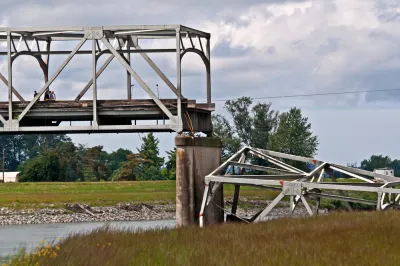Failing infrastructure is a life and death matter. Decaying roads, bridges, dam, pipelines, water delivery, and railroads lacking safety controls are responsible for the loss of thousands of lives annually, on top of illnesses and injuries.

"From coast to coast, the country’s once-envied collection of bridges, dams, pipelines, sewage treatment plants and levees is crumbling," writes Ron Nixon for The New York Times. "Studies have shown that a lack of investment in public infrastructure costs billions of dollars a year in lost productivity, as people sit in traffic or wait for delayed shipments."
However, costs go far beyond congestion. Public health, safety, and life itself are at stake. "Every year, hundreds of deaths, illnesses and injuries can be attributed to the failure of bridges, dams, roads and other decaying structures," writes Nixon.
The federal Department of Transportation (DOT) estimates that obsolete road designs and poor road conditions are a factor in about 14,000 highway deaths each year. Research by Ted Miller, a senior research scientist at the Pacific Institute for Research and Evaluation, which receives financing from the Transportation Department, put the medical cost of highway injuries from poor road conditions at $11.4 billion for 2013, according to the latest data available.
Nixon also writes about the loss of life due to other infrastructure failures including the lack of Positive Train Control for railroads, natural gas pipeline explosions, recent dam failures, disease outbreaks from "aging and crumbling water systems."
Much of America’s infrastructure was built many decades ago with the understanding that the structures would remain in place for no more than 50 years or so. But many structures have exceeded that age.
The six-year STRR Act that passed the House on Nov. 5 and the six-year DRIVE Act that passed the Senate on July 30 only keep transportation spending at current levels, adjusted for inflation, falling "far short of what many infrastructure experts say is needed, both in terms of time and money," notes Nixon.
“There is no question that there are safety impacts and loss of life because we didn’t take the time or spend the money to make infrastructure what it should be,” Anthony R. Foxx, the transportation secretary, said in an interview.
Joan Lowy of The Associated Press writes that Secretary Foxx indicated that a minimum of $400 billion over six years is needed. The STRR Act authorizes $325 billion, notes Lowy, though only has funds for the first three of the six years.
"President Obama, in his budget, had called for a larger, $478 billion program," writes
FULL STORY: Human Cost Rises as Old Bridges, Dams and Roads Go Unrepaired

National Parks Layoffs Will Cause Communities to Lose Billions
Thousands of essential park workers were laid off this week, just before the busy spring break season.

Retro-silient?: America’s First “Eco-burb,” The Woodlands Turns 50
A master-planned community north of Houston offers lessons on green infrastructure and resilient design, but falls short of its founder’s lofty affordability and walkability goals.

Delivering for America Plan Will Downgrade Mail Service in at Least 49.5 Percent of Zip Codes
Republican and Democrat lawmakers criticize the plan for its disproportionate negative impact on rural communities.

Test News Post 1
This is a summary

Test News Headline 46
Test for the image on the front page.

Balancing Bombs and Butterflies: How the National Guard Protects a Rare Species
The National Guard at Fort Indiantown Gap uses GIS technology and land management strategies to balance military training with conservation efforts, ensuring the survival of the rare eastern regal fritillary butterfly.
Urban Design for Planners 1: Software Tools
This six-course series explores essential urban design concepts using open source software and equips planners with the tools they need to participate fully in the urban design process.
Planning for Universal Design
Learn the tools for implementing Universal Design in planning regulations.
EMC Planning Group, Inc.
Planetizen
Planetizen
Mpact (formerly Rail~Volution)
Great Falls Development Authority, Inc.
HUDs Office of Policy Development and Research
NYU Wagner Graduate School of Public Service


























